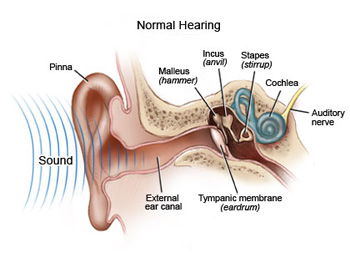How we hear
Get a hearing test at our audiologist clinic – CALL BURLINGTON’S HEARING SPECIALIST AT 905-635-HEAR (4327)
How do we hear anyways?
Understanding how your ears work can help you understand how your hearing loss occurs. Sound waves travel through each part of the ear to the brain, which decodes and makes sense of the signals.
The Outer Ear
The outer part of the ear you can see is called the pinna, which funnels sound waves into the ear canal. The ear canal is a short tube that allows sounds to reach the eardrum, also called the tympanic membrane.
The Middle Ear
The middle ear is an air-filled chamber connected to the back of the nose and throat by the Eustachian tube. This tube helps to equalise pressure on both sides of the eardrum. It’s usually closed, but it opens when you swallow or yawn.
When sound reaches the eardrum, the eardrum sends vibrations through three small bones called ossicle: the malleus, incus, and stapes – the smallest bones in the body. The ossicles amplify the vibrations from the eardrum and send them to the inner ear.
The Inner Ear
The cochlea, part of the inner ear, is filled with fluid and contains more than 15,000 microscopic sensory cells that convert sound vibration into nerve impulses. These impulses travel along the auditory nerve to the brain, which interprets them as meaningful sounds. The cochlea also connects with the vestibular system, which regulates our balance.

